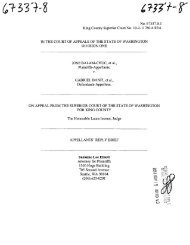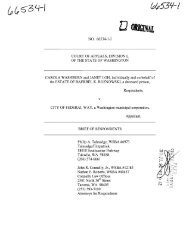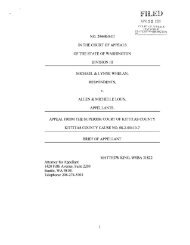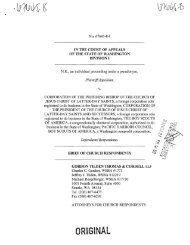Appellant's Brief - Washington State Courts
Appellant's Brief - Washington State Courts
Appellant's Brief - Washington State Courts
Create successful ePaper yourself
Turn your PDF publications into a flip-book with our unique Google optimized e-Paper software.
announced in Cady v. Dumbrowski, 413 U. S. 433,93 S. Ct. 2523,<br />
37 L. Ed. 2d 706 (1973), and expanded by subsequent <strong>Washington</strong><br />
cases to cover situations involving either emergency aid or routine<br />
health and safety checks. <strong>State</strong> v. Kinzy, 141 Wn.2d 373, 385-86,<br />
5 P.3d 668 (2000). The greater the emergency, the greater the<br />
intrusion permitted. The emergency aid function applies when "(1)<br />
the officer subjectively believed that someone likely needed<br />
assistance for health or safety reasons; (2) a reasonable person in<br />
the same situation would similarly believe that there was a need for<br />
assistance; and (3) there was a reasonable basis to associate the<br />
need for assistance with the place searched." Kinzy, supra, at 386.<br />
Whether the officer acted in an objectively reasonable manner is<br />
"evaluated in relation to the scene as it reasonably appeared to the<br />
officer at the time, 'not as it may seem to a scholar after the event<br />
with the benefit of leisured retrospective analysis. " Johnson,<br />
supra, at 420.<br />
The emergency aid doctrine is different from the exigent<br />
circumstances exception to the warrant requirement in that the<br />
emergency aid doctrine does not involve the investigation of a<br />
crime but aiding persons believed to be in danger of physical harm<br />
or death. Kinzy, supra, at 387. Nevertheless, it will be noted in a
















